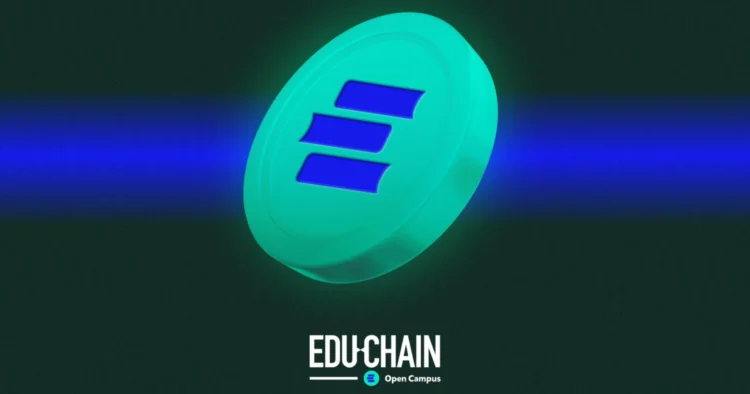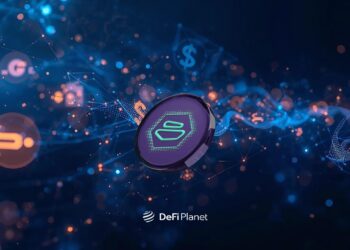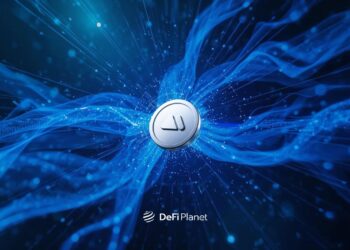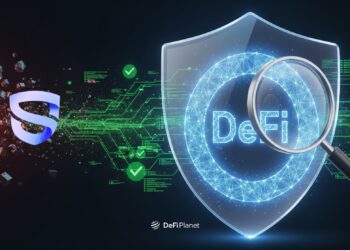The education space has seen its fair share of innovation, but with many platforms promising better access, more flexibility, and improved learning experiences, it’s tough to separate the game-changers from the gimmicks. One area gaining significant traction is learn-to-earn (L2E), where learners are rewarded with crypto as they engage in educational content.
Open Campus (EDU) is one of the most ambitious players in this space. Built with blockchain technology, Open Campus aims to empower educators, provide real incentives for students, and create a decentralized education ecosystem. By leveraging the power of Web3, Open Campus offers a novel approach to education that promises to give users ownership of their learning journeys and rewards for their progress.
But with such big promises, it’s worth asking: Can Open Campus EDU truly disrupt the traditional education system, or is it just another buzzworthy idea in the blockchain space?
Let’s explore Open Campus’s features, delve into how it works, and evaluate whether it has the potential to transform education or is simply riding the latest crypto trend.
How Does Open Campus EDU Work?
Open Campus EDU lets creators use different tools to make educational content in all sorts of formats. With these tools, you can create interactive learning experiences for your audience.

- TinyTap lets creators design fun, interactive games and courses.
- Mocaverse helps build immersive learning environments in the metaverse.
Creators can mix and match these tools to build the type of learning content they want, whether it’s games, virtual reality experiences, or traditional lessons. This flexibility makes it easy for creators to bring their ideas to life and share them with a global audience.
Open Campus (EDU) Learn-to-Earn Model Explained
The Learn-to-Earn (L2E) model, as implemented by Open Campus EDU, redefines the traditional learning experience by directly rewarding participants for their educational engagement.
This approach leverages blockchain technology to create a decentralized education ecosystem where learners, content creators, and educational institutions can all benefit from their involvement.
- For Learners:
Learners earn rewards by actively engaging with educational content. This can include completing courses, participating in quizzes, interacting with supplementary materials, and demonstrating mastery of the subject matter.
By doing so, learners accumulate EDU tokens, which can be used for various purposes within the Open Campus ecosystem, such as unlocking further content, purchasing additional courses, or even trading for other cryptocurrencies.
The model provides a direct incentive for learners to invest in their education, ensuring that their time and effort are financially recognized.
- For Content Creators:
Content creators, such as instructors, course developers, and educational institutions, can monetize their work by publishing their courses on the Open Campus EDU platform. When learners purchase and engage with these courses, content creators earn EDU tokens as compensation.
Additionally, content creators can collaborate with other parties, such as co-publishers or localizers, who can also earn rewards through a revenue-sharing model. This creates a robust incentive structure that encourages the creation of high-quality, engaging educational materials.
- For Educational Institutions:
Educational institutions, whether traditional or blockchain-based, can participate in the Open Campus EDU ecosystem by offering accredited courses or programs. These institutions can generate revenue through course sales and engage in partnerships with content creators.
Moreover, institutions have the opportunity to offer their students a unique, blockchain-based credentialing system, enhancing the value of their certifications in the digital age. The transparency of blockchain also allows institutions to track learner progress and improve the quality of their offerings based on real-time feedback and data.
Incentives for Learners, Content Creators, and Educational Institutions
The L2E model incentivizes all participants by directly tying rewards to educational engagement and success:
- Learners: Earn EDU tokens for course completion, active participation, and skill acquisition. These tokens can then be reinvested into the platform or converted into real-world value, creating a sustainable loop of continuous learning and earning.
- Content Creators: Earn EDU tokens based on the consumption of their courses. In addition to direct payments, creators are incentivized to improve the quality of their content and expand their reach to gain more users and thus more rewards.
- Educational Institutions: Benefit from new revenue streams as they transition to blockchain-based education. They can offer blockchain-verified credentials, track student performance, and participate in a global education network that brings new opportunities for both learning and teaching.
Other Features That Set Open Campus EDU Apart
Open Campus EDU offer advanced features that make the learn-to-earn process seamless:
Decentralized Content Publishing and Ownership
Open Campus enables educators to mint their courses as Publisher NFTs, representing ownership and revenue rights over the content. These NFTs can be bought and co-published by others, such as translators or local partners, creating a global, distributed network of content collaborators.
By decentralizing publishing rights, Open Campus EDU empowers educators to maintain control over their work while tapping into new monetization channels, something traditional educational platforms typically lack.
Creator Economy for Educators
Open Campus empowers educators to become true owners of their work in a decentralized, Web3-driven creator economy. Instead of relying on traditional institutions for employment or distribution, educators can directly publish, monetize, and collaborate on educational content.
Through smart contracts, they earn ongoing royalties based on real impact and reach. This model promotes innovation, values transparency, and creates new pathways for underrepresented educators, especially in emerging markets, to reach global audiences and grow independently.
Reputation Systems and Credentialing via Blockchain
Open Campus utilizes blockchain to create verifiable, tamper-proof records of educational achievements and reputation scores. Learners can earn digital credentials that are permanently stored on-chain, providing transparency for employers and institutions.
At the same time, educators can build reputations based on student feedback and course engagement metrics. These blockchain-based credentials are designed to be portable, borderless, and resistant to fraud, offering a new standard for trust in digital education.
Comparison with Other Web2 platforms: How Does Open Campus EDU Stack Up?
Here’s a clear side-by-side comparison of how Decentralized Duolingo compare to existing competitors:

Open Campus EDU Accessibility and Global Reach
One of the most powerful aspects of Open Campus is its potential to empower underserved and underbanked populations. Globally, traditional education systems are either too expensive, too centralized, or simply out of reach. Open Campus addresses this by:
- Enabling permissionless participation: Anyone with internet access can learn, earn, and contribute without the need for a formal institution or bank account.
- Using crypto-based payments and incentives: With the EDU token, learners and creators can earn and transact without relying on traditional financial systems. This is especially useful in regions with limited banking infrastructure.
- Offering blockchain-based credentials: Learners can build verifiable educational records without needing to rely on institutions that may not be accessible or trusted.
By prioritizing accessibility and decentralization, Open Campus brings real educational opportunities to millions who have historically been left out of the system.
Challenges and Criticisms of Open Campus EDU
While Open Campus EDU offers various benefits, several challenges and criticisms may hinder its long-term success and mainstream adoption.

Sustainability of the Reward System
A big part of Open Campus is its reward system, where both learners and creators earn EDU tokens for their participation. However, for the platform to remain functional in the long term, a steady stream of users must engage with courses and utilise EDU tokens.
If the token’s value drops or if too many rewards are distributed, people may lose interest, and the platform could face issues. To maintain balance, Open Campus requires a sophisticated system that rewards users without compromising the value of the EDU token.
The Impact of Token Price Volatility
Since EDU tokens are used for rewards and transactions, the price of these tokens can influence how much people are willing to use the platform.
If the price becomes volatile, learners might hesitate to earn tokens because they fear losing value, and creators might feel uncertain about their rewards. To keep users happy, it’s important for Open Campus to find ways to stabilize the token price and avoid big swings.
Risk of Low-Quality Content
Open Campus’s decentralized education nature is great, but it also means anyone can create and upload educational content. Some creators might focus on quantity over quality just to earn more rewards. If that happens, it could make it harder for learners to find high-quality and trustworthy courses.
To address this, the platform could introduce systems to reward creators for high-quality content and involve the community in moderation to ensure things stay on track.
Barriers to Adoption
For Open Campus to really take off, one big challenge is making sure people understand how to use the platform. Even with a simple interface, blockchain-based platforms require some knowledge of cryptocurrency and wallet management. This can be intimidating for those unfamiliar with crypto.
Future of Learning or Flash in the Pan?
Open Campus EDU presents a bold vision for the future of education by merging blockchain technology with the Learn-to-Earn model, offering a promising alternative to traditional education systems. What to watch moving forward will include partnerships with educational institutions and blockchain platforms, which will be key to expanding Open Campus’ reach. The platform’s ability to attract and retain learners, content creators, and institutions will determine its success.
Additionally, EDU highlights the potential of Web3 to reshape education, offering decentralized solutions to issues like credentialing and content ownership. If successful, it could pave the way for a more open, accessible, and rewarding education system in the digital age. However, its real impact will depend on its ability to strike a balance between innovation, sustainability, and usability.
Disclaimer: This article is intended solely for informational purposes and should not be considered trading or investment advice. Nothing herein should be construed as financial, legal, or tax advice. Trading or investing in cryptocurrencies carries a considerable risk of financial loss. Always conduct due diligence.
If you would like to read more articles like this, visit DeFi Planet and follow us on Twitter, LinkedIn, Facebook, Instagram, and CoinMarketCap Community.
Take control of your crypto portfolio with MARKETS PRO, DeFi Planet’s suite of analytics tools.”





















